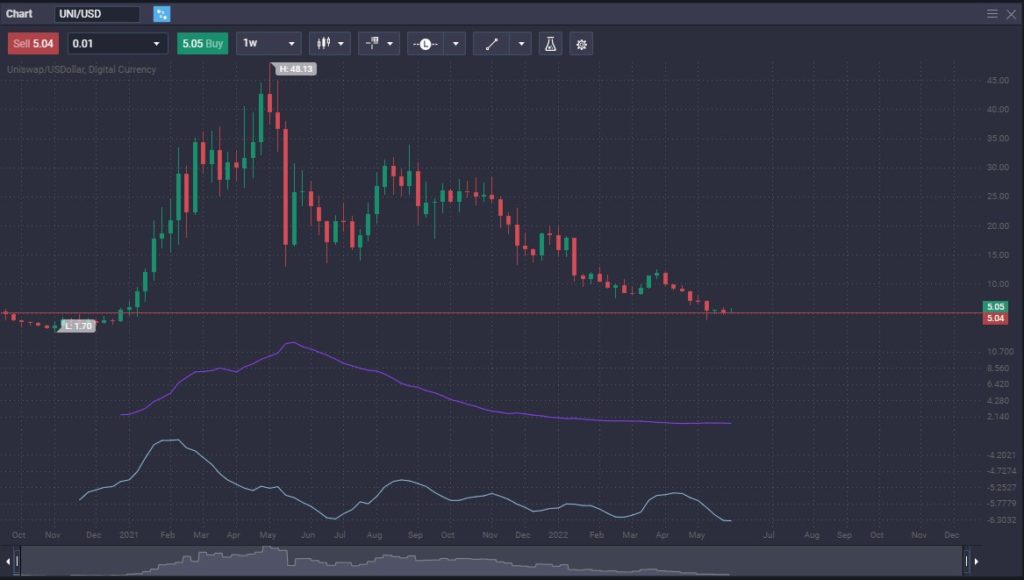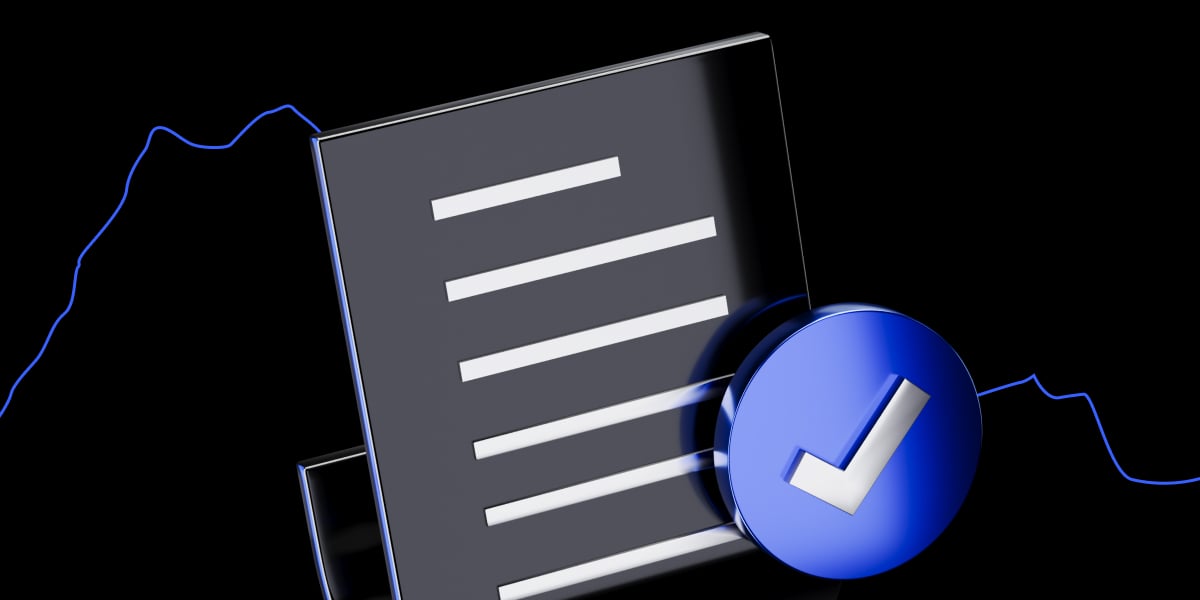Uniswap is an automated Ethereum-based crypto exchange. It has its governance token, UNI. It is a leading decentralized crypto exchange that allows traders to exchange tokens without needing a third party or “middleman.” It is also one of the favored venues for “yield farming.”
What is Uniswap? – Definition & Meaning

Uniswap is the biggest decentralized crypto exchange (DEX) running on the Ethereum blockchain. It has a native governance token called UNI. It allows smart contracts to facilitate the trading of ERC-20 tokens for one another, acting as an automated market maker (AMM), getting rid of the need for a third party or “middleman” to facilitate the transaction.
Uniswap was one of the first places where an AMM was available; crypto holders often use it to earn yield as they offer liquidity. Parking your tokens on Uniswap allows other traders to borrow, lend, and exchange tokens in a “trustless format.”
Uniswap History
Uniswap was created on November 2, 2018, and deployed to the Ethereum mainnet. The founders had roughly 200 Twitter followers when they announced this. For most people, this was the first time they had heard of the project, and therefore it was received with little fanfare.
As Hayden Adams was laid off from work in July 2017, he conversed with a friend Karl Floersch about his future direction. Karl was working on Casper FFG at the Ethereum Foundation. He informed Adams about the future of being involved in smart contracts. Adam started learning how to code Solidity, the language of Ethereum, and JavaScript.
Adams decided to work on a “real project” by forming an automated market maker. This became a proof-of-concept project, including a smart contract and the first Uniswap website. The contract had a single liquidity provider and allowed simple swaps.
Adams began to “go down the rabbit hole” regarding options on swaps and cryptocurrency in general. It is from here that Uniswap was eventually born. At Devcon 3, Floersch used the Uniswap demo as an example of the power of crypto-economics. It was at this conference that Pascal Van Hecke first heard about Uniswap.
Pascal brought new ideas to the project and, more importantly, brought a sense of structure and accountability. At this point, Uniswap only worked on a single ETH/ERC-20 pair. It also only worked with one liquidity provider.
After meeting Vitalik Buterin on a trip to Korea, Adams applied for a grant from the Ethereum Foundation, as Uniswap then became a full-time project.
Who is Behind Uniswap (UNI)?
Uniswap was created by Hayden Adams, a former mechanical engineer at Siemens, on November 2, 2018. The Uniswap company has received investments from venture capital firms such as Paradigm Venture Capital, Union Square Ventures LLC, etc.
Why Was UNI Created?
Uniswap was designed to solve decentralized exchanges’ liquidity issues. This allows the exchange to swap tokens without relying on buyers and sellers to create that liquidity. Smart contracts build liquidity pools, allowing for a “trustless system” that people can take advantage of.
Uniswap is designed to function as a public good, a tool for the community to trade tokens without platform fees or intermediaries. Unlike most major exchanges, which will match a buyer and a seller to determine prices and execute trades, Uniswap uses a math equation in pools of tokens and ETH to do the same job.
Uniswap Expands with V2 and V3
Even though Uniswap launched in November 2018, it wasn’t until 2020 that the protocol started to see significant usage. During the release of Uniswap V2 in May, this saw a considerable upgrade allowing for direct ERC-20 to ERC-20 swaps, getting rid of Wrapped Either whenever possible. Uniswap V2 also added support for previously incompatible trades between ERC-20 tokens. Some pretty technical improvements made it more desirable to use.
Yield farming and liquidity mining platforms increased in popularity during 2020, and yield swaps saw a corresponding surge in interest. Many DeFi platforms allow Uniswap liquidity providers to gain an additional return on their liquidity provider tokens. This and the 0.3% exchange fees distributed to liquidity providers have seen Uniswap rise to one of the world’s leading DeFi platforms.
In May 2021, Uniswap V3 launched, adding several new features. Concentrated liquidity, which allows liquidity providers to allocate liquidity within a custom price range, has been an enormous success. This means that traders do not have to put up as much capital to achieve results as they can keep from making transactions at less desirable prices.
Uniswap V3 also added tiers of fees to enable traders to determine the amount of risk they will take when trading volatile assets. This helps with slippage, making for more accessible and cheaper transactions. Uniswap V3 also generates nonfungible tokens based upon liquidity provider positions, turning them into “on-chain generated art.”
How does Uniswap work?
The Uniswap protocol is on the Ethereum blockchain and is used for swapping all ERC-20 tokens. By being decentralized, Uniswap can be used to facilitate the swaps without interference. This means that unlike a centralized exchange set up to charge fees, Uniswap is designed as a tool for the community to trade these tokens without significant fees.
Uniswap uses the automated market maker (AMM) model as an order matching system. The model powers most decentralized exchanges and does away with the traditional order book. Rather than stating the current price of an asset, AMM connects liquidity pools through smart contracts, allowing the pools to execute trades according to programmed algorithms.
Automated Liquidity Protocol
An automated liquidity protocol is a process in which smart contracts use blockchain technology to create transactions that execute automatically when particular conditions are met. By forgoing any middleman or third party, smart contracts are much more secure and efficient.
On Uniswap, both individuals and bonds contribute to the exchange’s liquidity by adding pairs of tokens to smart contracts traded to and from other users. By contributing liquidity, holders of UNI earn a percentage of the trading fees. For each trade, tokens are removed from the pool for an amount of the other token, thereby keeping an automated price.
How does an Automated Liquidity Pool Work?
Automated liquidity pools solve liquidity issues which can be a common problem for centrally controlled exchanges. Centralized exchanges depend on having enough volume to meet the needs of buyers and sellers. Uniswap users are incentivized to pool their money in a fund that any trader can draw upon to complete a trade, reap the rewards, or do a process known as yield farming. Smart contracts determine the prices of various types of crypto as they all have their individual liquidity pools.
Yield farming relies on liquidity providers to deposit funds into liquidity pools. These pools allow DeFi users to borrow, lend, and swap tokens. The users pay a small fee, which is shared with liquidity pools based on how much they provide to the pool.
Uniswap vs. PancakeSwap
One of the most significant differences between Uniswap and PancakeSwap is the network that they are running on. Uniswap is on the Ethereum blockchain, while PancakeSwap is on the Binance Smart Chain. Uniswap operates with ERC-20 tokens, while PancakeSwap interacts with BNB and BEP-20 tokens, assets on the Binance Smart Chain.
Architecturally speaking, both protocols function very similarly. Both protocols allow multiple crypto wallets, and both use automated market-making technology to process trades and allow liquidity providers to firm rewards in crypto.
Platform fees are similar, with Uniswap being 0.3%, while PancakeSwap is slightly better at 0.25%. The most significant advantage that PancakeSwap has over Uniswap will be the gas fees, which typically are much lower on the Binance Smart Chain than on the Ethereum network. However, Ethereum is currently upgrading its market and its scalability, which should, in theory, at least, drive down gas fees.
The Binance Smart Chain has just a few dozen validators, while Ethereum has over 200,000. This does raise the possibility of censorship and centralized DeFi. Average traders wanting to make a transaction, especially a small one, typically do not worry about centralization.
What is Uniswap (UNI) token?
Uniswap (UNI) is an Ethereum token used to power Uniswap, an automated liquidity provider. The automated liquidity provider makes it easy to exchange Ethereum (ERC-20) tokens. Tokens are exchanged through liquidity pools that are defined by smart contracts.
How are Tokens Produced in Uniswap?
Uniswap tokens are produced whenever new ETH/ERC-20 tokens are contributed to a Uniswap liquidity pool. The contributor receives a “pool token,” also an ERC-20 token.
Pool tokens can be freely exchanged, mood, and used in other dApps. When funds are reclaimed, the pool tokens are burned or destroyed. Every pool token will represent a user share of the total assets of the pool and a share of the pool’s 0.3% trading fee.
How to use Uniswap
Uniswap is open-sourced, meaning that anyone could create their own front and application for it. As one would expect, the most commonly used one is the official Uniswap Exchange. The Uniswap Exchange can be found at https://uniswap.exchange.
To use Uniswap, you go to the Uniswap interface and connect your wallet. There are a handful of wallets that you can use; all, of course, will have to be Ethereum wallets. You then select the token you’d like to exchange from and the token you would like to exchange for. Click on “Swap” and preview the transaction in the pop-up window.
Confirm the transaction requesting your wallet and wait for the transaction to be confirmed on the Ethereum blockchain. You can monitor its status on https://etherscan.io/.
What Are the Advantages of Uniswap?
As Uniswap has enjoyed enormous growth, one would anticipate that there are a lot of advantages to using it. As Uniswap is evolving, it is adding more functionality to its automated market maker protocol, trying to become the “open-air market” of the Ethereum blockchain.
Open source – Uniswap is open source. It means it can be adapted by other users trying to create new DeFi projects.
AMM – Using an automated market maker, users can contribute to liquidity pools and earn rewards. Users can trade ERC-20 tokens easily and at a relatively low cost.
UNI – It has a native token, called UNI, that allows holders to vote on changes to the platform.
DEX – As a decentralized exchange, Uniswap allows users to keep control of their crypto assets. Users retain control of their private keys, reducing the risk of those assets being hacked.
What Are the Disadvantages of Uniswap?
Although Uniswap is a beneficial protocol, nothing is perfect, and there are a few things that you should be aware of.
Crypto only – Uniswap does not allow purchasing of crypto with fiat currency, so you will need to own crypto before you can use the platform.
Gas fees – Ethereum blockchain gas fees can be expensive at times, and Uniswap is a bit of a victim of this. However, Ethereum is presently working on driving these fees down.
Risk of impermanent loss – Impermanent loss can happen by the net difference between the value of two cryptocurrency assets in a liquidity pool. It happens by simply holding assets in a cryptocurrency wallet, as the values fluctuate over time.
Is Uniswap a Good Investment?

Uniswap took off quite drastically in 2021, as it had considerable gains over a very short amount of time. However, the entire altcoin market took a nosedive in 2022, and UNI wasn’t spared. That being said, during 2022, the total trades on the Uniswap DEX reached the $1 trillion mark.
Analysts are all over the place when it comes to the future of Uniswap, which makes considerable sense when it has so much outside influence from other cryptocurrencies. After all, the demand for Uniswap will be significantly influenced by the demand for crypto, to begin with. The less demand there is the less demand for swaps.
However, if crypto continues to see mass adoption, Uniswap might be an excellent way to play the overall market instead of going “all in” on one particular coin. Most analysts see the value of Uniswap rising over the next several years. Still, the reality is that the trajectory of that price appreciation should be much slower than it was in 2021. This is why using the CFD market at PrimeXBT may be the best way to go, allowing greater profit for those wishing to speculate in a market that will have its ups and downs.
Conclusion
Uniswap has enjoyed enormous success relatively quickly. It is a protocol built on the Ethereum blockchain, so although it has the advantage of allowing people with Ethereum wallets to exchange tokens without the involvement of a central party, it is somewhat held hostage by the Ethereum blockchain itself.
The one advantage of being on the Ethereum blockchain is that Ethereum is not going anywhere. In other words, you do not have to worry about the underlying blockchain disappearing anytime soon. Uniswap has a lot of potential uses, not the least of which are the implications of having trustless token swapping. Once the Ethereum 2.0 scalability solutions get completed, Uniswap will more likely than not benefit from them.
Therein lies the rub: Ethereum has been very slow to move forward, so this is a bit of a hindrance for Uniswap, at least in the short term. Longer-term, it could be a valuable part of the Ethereum ecosystem as it serves a vital role, allowing for a sort of “foreign exchange” for crypto.
What is the purpose of Uniswap?
Uniswap is a decentralized exchange (DEX) that allows peer-to-peer market marking. This will enable traders to exchange cryptocurrency with each other without needing a third party.
Is Uniswap safe?
Yes. It is very safe as it functions as a decentralized exchange and liquidity pool. It is built on Ethereum, giving it the same ability to offer security as Ethereum does.
Is Uniswap a coin or token?
It is a token that powers Uniswap, the DEX. All liquidity is exchanged through pools that are defined by smart contracts.
Does Uniswap have a future?
Uniswap could have a bright future, but it will also depend on the overall adoption of crypto. As it acts as an intermediary, there needs to be enough demand for various coins and tokens.
Why is Uniswap valuable?
Uniswap can directly swap their cryptocurrency with others from Ethereum wallets, so there is no need to worry about the chain of custody. This significantly lowers the risk of being hacked, which adds a layer of security that centralized exchanges aren’t capable of.
The content provided here is for informational purposes only. It is not intended as personal investment advice and does not constitute a solicitation or invitation to engage in any financial transactions, investments, or related activities. Past performance is not a reliable indicator of future results.
The financial products offered by the Company are complex and come with a high risk of losing money rapidly due to leverage. These products may not be suitable for all investors. Before engaging, you should consider whether you understand how these leveraged products work and whether you can afford the high risk of losing your money.
The Company does not accept clients from the Restricted Jurisdictions as indicated in our website/ T&C. Some services or products may not be available in your jurisdiction.
The applicable legal entity and its respective products and services depend on the client’s country of residence and the entity with which the client has established a contractual relationship during registration.




